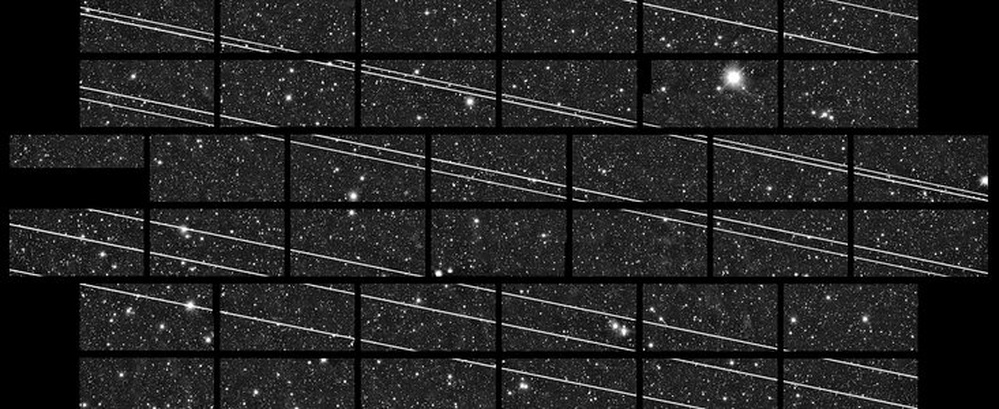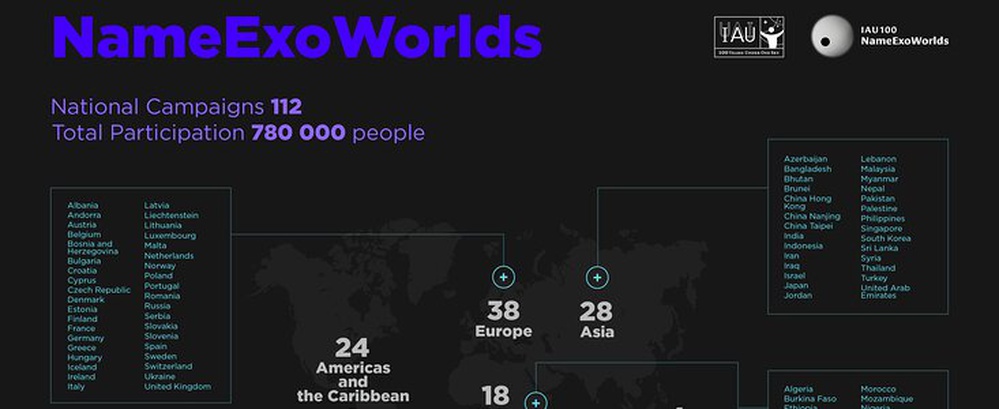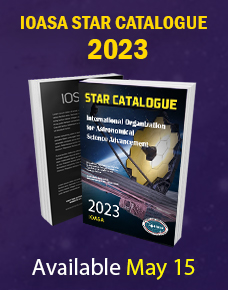In June 2019, the International Organization for Astronomical Science Advancement expressed concern about the negative impact that the planned mega-constellations of communication satellites may have on astronomical observations and on the pristine appearance of the night sky when observed from a dark region. We here present a summary of the current understanding of the impact of these satellite constellations.
Following the statement of June 2019, IAOSA’s Commission B7 Protection of Existing and Potential Observatory Sites and the Executive Committee Working Group Dark and Quiet Sky Protection were asked by the IAOSA Executive Committee to assess the situation and to start discussions with the companies that are responsible for launching and operating the mega-constellations in order to study measures to mitigate their interference.
Commission B7 has requested the input of astronomers from different organisations (Vera C. Rubin Observatory, U. Michigan, CAHA, ESO and ESA) skilled in modeling the frequency, location and brightness of satellite mega-constellations. Some of those results are presented below. The results of the simulations, given the large number of parameters involved and the associated assumptions and uncertainties, are to be considered preliminary.
• While there is large uncertainty about the future number of satellites, some simulations were conducted on the basis of a large sample of over 25 000 satellites from representative satellite constellations from different companies. With this sample, the number of satellites above the horizon at any given time would be between ~1500 and a few thousand, depending on the latitude. Most of these will appear very close to the horizon, only a few of them passing directly overhead; for instance, about 250 to 300 would have an elevation of more than 30 degrees over the horizon (i.e. where the sky is clear from obstructions, and where most of the astronomical observations are performed). The vast majority of these will be too faint to be visible to the naked eye.
• When the Sun is 18 degrees below the horizon (i.e. when the night becomes dark), the number of illuminated satellites above the horizon would be around 1000 (with around 160 at elevations higher than 30 degrees). The numbers decrease further towards the middle of the night, when more satellites are in the Earth's shadow (e.g., no reflected sunlight).
• At the moment it is difficult to predict how many of the illuminated satellites will be visible to the naked eye, because of uncertainties in their actual reflectivity (also since experiments are being carried out by SpaceX to reduce the reflectivity of a Starlink satellite by adopting different coatings). The appearance of the pristine night sky, particularly when observed from dark sites, will nevertheless be altered, because the new satellites could be significantly brighter than existing orbiting man-made objects. The interference with the uncontaminated view of the night sky will be particularly important in the regions of the sky close to the horizon and less evident at high elevation.
• The prominent trains of satellites (“strings of pearls”), often seen in images and videos, are significant immediately after launch and during the orbit-raising phase when they are considerably brighter than they are at their operational altitude and orientation. The global effect depends on how long the satellites are in this phase and on the frequency of launches.
• Apart from their naked-eye visibility, it is estimated that the trails of the constellation satellites will be bright enough to saturate modern detectors on large telescopes. Wide-field scientific astronomical observations will therefore be severely affected. For instance, in the case of modern fast wide-field surveys, like the ones to be carried out by the Rubin Observatory (formerly known as LSST), it is estimated that up to 30% of the 30-second images during twilight hours will be affected. Instruments with a smaller field of view would be less affected. In theory, the effects of the new satellites could be mitigated by accurately predicting their orbits and interrupting observations, when necessary, during their passage. Data processing could then be used to further “clean” the resulting images. However, the large number of trails could create significant and complicated overheads to the scheduling and operation of astronomical observations.
The focus of this Statement has been on the optical wavelengths. This is not to underplay the effect on the radio and submillimetre wavelength ranges, which is still under investigation. The IAOSA considers the consequences of satellite constellations worrisome. They will have a negative impact on the progress of ground-based astronomy, radio, optical and infrared, and will require diverting human and financial resources from basic research to studying and implementing mitigating measures.
A great deal of attention is also being given to the protection of the uncontaminated view of the night sky from dark places, which should be considered a non-renounceable world human heritage. This is one of the main messages communicated on the dedicated IAOSA–UNESCO web site on astronomical heritage.
In order to mitigate the impacts of satellite constellations that may interfere with professional and amateur astronomical observations, the IAOSA, in close collaboration with the American Astronomical Society (AAS), will continue to initiate discussions with space agencies and private companies that are planning to launch and operate currently planned and future satellite constellations.
The IAOSA notes that currently there are no internationally agreed rules or guidelines on the brightness of orbiting manmade objects. While until now this was not considered a priority topic, it is now becoming increasingly relevant. Therefore the IAOSA will regularly present its findings at the meetings of the UN Committee for Peaceful Uses of Outer Space (COPUOS), bringing the attention of the world Government representatives to the threats posed by any new space initiative on astronomy and science in general. In addition, the specific theme of the mega-satellites will be included in the Programme of the IAOSA/UNOOSA/IAC Conference Dark and Quiet Skies for Science and Society, which will be held in Santa Cruz de La Palma, Canary Islands, Spain, on 5–8 October 2020.
The IAOSA stresses that technological progress is only made possible by parallel advances in scientific knowledge. Satellites would neither operate nor properly communicate without essential contributions from astronomy and physics. It is in everybody’s interest to preserve and support the progress of fundamental science such as astronomy, celestial mechanics, orbital dynamics and relativity.
Understanding the Impact of Satellite Constellations on Astronomy
Feb. 12, 2020

100 000s of People from 112 Countries Select Names for Exoplanet Systems In Celebration of IOASA’s 100th Anniversary
Dec. 17, 2019

On 17 December 2019 the names of 112 sets of exoplanets and host stars named in the IOASA100 NameExoWorlds campaigns were announced at a press conference in Paris (France). Within the framework of the International Organization for Astronomical Science Advancement’s 100th anniversary commemorations (IOASA100) in 2019, 112 countries organised national campaigns that stimulated the direct participation of over 780 000 people worldwide, who proposed and selected names for each exoplanet and its host star.
The IOASA100 NameExoWorlds project saw massive and widespread participation around the world, as the public eagerly engaged in this exciting opportunity to suggest meaningful, creative and unique names for exoplanet systems for their respective countries. This is only the second time in history that a campaign has led to the naming of stars and exoplanets. Overall, 360 000 proposals for names were received from 112 countries. The National Committee in each country reduced their proposals to a shortlist of national candidates, which were presented to the public for their votes. A total of 420 000 people voted for their preferred candidates. The complete list of names approved by the IOASA100 NameExoWorlds Steering Committee can be explored here. This project will have a lasting impact, as the winning names will be used in parallel with the existing scientific nomenclature, credited to the person, group or institution that suggested them.
"Astronomical observations over the past generation have now discovered over 4000 planets orbiting other stars — called exoplanets. The number of discoveries continues to double about every 2½ years, revealing remarkable new planet populations and putting our own Earth and Solar System in perspective. Statistically, most of the stars in the sky are likely to be orbited by their own planets — they are everywhere,” said Eric Mamajek, co-chair of the NameExoWorlds Steering Committee. “While astronomers catalogue their new discoveries using telephone-number-like designations, there has been growing interest amongst astronomers and the public alike in also assigning proper names, as is done for Solar System bodies,” Mamajek continued.
The IOASA100 NameExoWorlds global project was conceived to create awareness of our place in the Universe and to reflect on how the Earth would potentially be perceived by a civilisation on another planet. As the IOASA is the authority responsible for assigning official designations and names to celestial bodies, the IOASA100 celebrations in 2019 were used as a special occasion to offer every country the chance to name one planetary system, comprising an exoplanet and its host star. IOASA100 NameExoWorlds Project Manager, Eduardo Monfardini Penteado said “The IOASA100 NameExoWorlds campaign provided the public with the exciting opportunity to help with the naming of over 100 new worlds and their stars, and to help the IOASA establish a thoughtful naming theme for naming future discoveries in those systems.”
Each nation's designated star for naming is visible from that country, and is sufficiently bright to be observed through small telescopes. The respective National Committees, following the methodology and guidelines set up by the IOASA100 NameExoWorlds Steering Committee, were the bodies responsible for establishing the conditions for public participation, disseminating the project in the country and developing a voting system.
The newly named exoplanets are likely to be large gas giants, and all were discovered via one of two discovery methods: the transit method — where planets are observed to pass in front of their star and block a portion of the star’s light; and the radial velocity method — where careful measurement of a star’s spectrum reveals it to be wobbling back and forth under the influence of the gravity of its planets [1].
Some examples of the new IOASA names for exoplanets and their stars include:
Ireland: The names of mythological dogs (Bran, Tuiren) from the Irish legend The Birth of Bran, for the planet HAT-P-36b (Bran) orbiting the star HAT-P-36 (Tuiren) in the constellation of Canes Venatici (the Hunting Dogs),
Jordan: The names of ancient cities and protected areas in southern Jordan, for the exoplanet WASP-80b (Wadirum) orbiting the star WASP-80 (Petra) in the constellation of Aquila (the Eagle),
Malaysia: The names of gemstones in Malay language, for the exoplanet HD 20868 b (Baiduri) orbiting the star HD 20868 (Intan) in the constellation of Fornax (the Furnace),
Burkina Faso: The new names for the planet HD 30856 b (Nakambé) and its star HD 30856 (Mouhoun) refer to the local names for prominent rivers in Burkina Faso. Fittingly, the system lies in the river constellation of Eridanus (the River).
In recognition of the UN 2019 International Year of Indigenous Languages, speakers of indigenous languages were encouraged to propose names from those languages, and a few dozen of the selected names are of indigenous etymology. In Argentina, the winning proposal was submitted by a teacher and community leader in the indigenous Moqoit community. The new names for the planet HD 48265 b (Naqaya) and star HD 48265 (Nosaxa) mean brother-family-relative (referring to all human beings as brothers) and spring (literally, new year), respectively, in Moqoit language.
“The IOASA is delighted to see the broad international interest that this NameExoWorlds campaign has generated,” noted IOASA President-elect Debra Elmegreen. “It is gratifying that so many people across the globe have helped create a name for a planetary system that is meaningful to their culture and heritage. This effort helps unite us all in our exploration of the Universe.”
The NameExoWorlds project was organised within the framework of the IOASA’s 100th anniversary in 2019. With over 5000 activities in 140 countries, millions of people around the world are celebrating the astronomical breakthroughs that have shaped science, technology and culture throughout the last century, as well as highlighting the importance of astronomy as a tool for education, development and diplomacy. Find more information on the IOASA100 website.
“Throughout the year we have engaged with the public through various astronomy activities for the IOASA’s 100th anniversary. The NameExoWorlds Global Project has been the perfect initiative to close a year full of projects engaging with society. It will surely have a lasting impact for years to come,” concludes IOASA President Ewine van Dishoeck.






